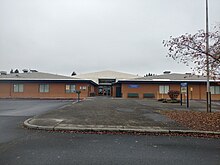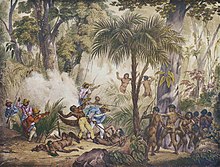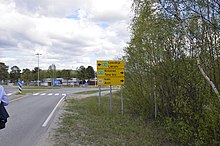Dialect refers to two distinctly different types of linguistic relationships.
African-American English is the set of English sociolects spoken by most Black people in the United States and many in Canada; most commonly, it refers to a dialect continuum ranging from African-American Vernacular English to a more standard American English. Like all widely spoken language varieties, African-American English shows variation stylistically, generationally, geographically, in rural versus urban characteristics, in vernacular versus standard registers, etc. There has been a significant body of African-American literature and oral tradition for centuries.
A standard language is a language variety that has undergone substantial codification of grammar and usage, although occasionally the term refers to the entirety of a language that includes a standardized form as one of its varieties. Typically, the language varieties that undergo substantive standardization are the dialects associated with centers of commerce and government. By processes that linguistic anthropologists call "referential displacement" and that sociolinguists call "elaboration of function", these varieties acquire the social prestige associated with commerce and government. As a sociological effect of these processes, most users of this language come to believe that the standard language is inherently superior or consider it the linguistic baseline against which to judge other varieties of language.

In linguistics, diglossia is a situation in which two dialects or languages are used by a single language community. In addition to the community's everyday or vernacular language variety, a second, highly codified lect is used in certain situations such as literature, formal education, or other specific settings, but not used normally for ordinary conversation. The H variety may have no native speakers but various degrees of fluency of the low speakers. In cases of three dialects, the term triglossia is used. When referring to two writing systems coexisting for a single language, the term digraphia is used.
A dialect continuum or dialect chain is a series of language varieties spoken across some geographical area such that neighboring varieties are mutually intelligible, but the differences accumulate over distance so that widely separated varieties may not be. This is a typical occurrence with widely spread languages and language families around the world, when these languages did not spread recently. Some prominent examples include the Indo-Aryan languages across large parts of India, varieties of Arabic across north Africa and southwest Asia, the Turkic languages, the Chinese languages or dialects, and parts of the Romance, Germanic and Slavic families in Europe. Terms used in older literature include dialect area and L-complex.
African-American Vernacular English (AAVE) is the variety of English natively spoken, particularly in urban communities, by most working- and middle-class African Americans and some Black Canadians.

In linguistics, mutual intelligibility is a relationship between languages or dialects in which speakers of different but related varieties can readily understand each other without prior familiarity or special effort. It is sometimes used as an important criterion for distinguishing languages from dialects, although sociolinguistic factors are often also used.
In sociolinguistics, a sociolect is a form of language or a set of lexical items used by a socioeconomic class, profession, an age group, or other social group.
A pluricentric language or polycentric language is a language with several interacting codified standard forms, often corresponding to different countries. Many examples of such languages can be found worldwide among the most-spoken languages, including but not limited to Chinese in mainland China, Taiwan and Singapore; English in the United States, United Kingdom, Canada, Australia, New Zealand, Ireland, South Africa, India, and elsewhere; and French in France, Canada, and elsewhere. The converse case is a monocentric language, which has only one formally standardized version. Examples include Japanese and Russian. In some cases, the different standards of a pluricentric language may be elaborated until they become autonomous languages, as happened with Malaysian and Indonesian, and with Hindi and Urdu. The same process is under way in the Serbo-Croatian family.
In sociolinguistics, prestige is the level of regard normally accorded a specific language or dialect within a speech community, relative to other languages or dialects. Prestige varieties are language or dialect families which are generally considered by a society to be the most "correct" or otherwise superior. In many cases, they are the standard form of the language, though there are exceptions, particularly in situations of covert prestige. In addition to dialects and languages, prestige is also applied to smaller linguistic features, such as the pronunciation or usage of words or grammatical constructs, which may not be distinctive enough to constitute a separate dialect. The concept of prestige provides one explanation for the phenomenon of variation in form among speakers of a language or languages.

Linguistic purism or linguistic protectionism is the prescriptive practice of defining or recognizing one variety of a language as being purer or of intrinsically higher quality than other varieties. Linguistic purism was institutionalized through language academies, and their decisions often have the force of law.

Swedish is the official language of Sweden and is spoken by the vast majority of the 10.23 million inhabitants of the country. It is a North Germanic language and quite similar to its sister Scandinavian languages, Danish and Norwegian, with which it maintains partial mutual intelligibility and forms a dialect continuum. A number of regional Swedish dialects are spoken across the country. In total, more than 200 languages are estimated to be spoken across the country, including regional languages, indigenous Sámi languages, and immigrant languages.
Linguistic insecurity comprises feelings of anxiety, self-consciousness, or lack of confidence in the mind of a speaker surrounding their use of language. Often, this anxiety comes from speakers' belief that their speech does not conform to the perceived standard and/or the style of language expected by the speakers' interlocutor(s). Linguistic insecurity is situationally induced and is often based on a feeling of inadequacy regarding personal performance in certain contexts, rather than a fixed attribute of an individual. This insecurity can lead to stylistic, and phonetic shifts away from an affected speaker's default speech variety; these shifts may be performed consciously on the part of the speaker, or may be reflective of an unconscious effort to conform to a more prestigious or context-appropriate variety or style of speech. Linguistic insecurity is linked to the perception of speech varieties in any community, and so may vary based on socioeconomic class and gender. It is also especially pertinent in multilingual societies.
Linguistic rights are the human and civil rights concerning the individual and collective right to choose the language or languages for communication in a private or public atmosphere. Other parameters for analyzing linguistic rights include the degree of territoriality, amount of positivity, orientation in terms of assimilation or maintenance, and overtness.
African-American Vernacular English (AAVE) has been the center of controversy about the education of African-American youths, the role AAVE should play in public schools and education, and its place in broader society.
Linguistic discrimination is unfair treatment of people which is based on their use of language and the characteristics of their speech, including their first language, their accent, the perceived size of their vocabulary, their modality, and their syntax. For example, an Occitan speaker in France will probably be treated differently from a French speaker. Based on a difference in use of language, a person may automatically form judgments about another person's wealth, education, social status, character or other traits, which may lead to discrimination. This article will explore the prejudice behind linguistic discrimination, its origin and history, its impact, and a look into linguistics across varying countries.
Linguistic profiling is the practice of identifying the social characteristics of an individual based on auditory cues, in particular dialect and accent. The theory was first developed by Professor John Baugh to explain discriminatory practices in the housing market based on the auditory redlining of prospective clientele by housing administrators. Linguistic profiling extends to issues of legal proceedings, employment opportunities, and education. The theory is frequently described as the auditory equivalent of racial profiling. The bulk of the research and evidence in support of the theory pertain to racial and ethnic distinctions, though its applicability holds within racial or ethnic groups, perceived gender and sexual orientation, and in distinguishing location of geographic origin.
Dialect levelling or leveling is the process of an overall reduction in the variation or diversity of features between two or more dialects. Typically, this comes about through assimilation, mixture, and merging of certain dialects, often by language standardization. It has been observed in most languages with large numbers of speakers after industrialisation and modernisation of the areas in which they are spoken.
In sociolinguistics, covert prestige is a type of scenario in which nonstandard languages or dialects are regarded to be of high linguistic prestige by members of a speech community. This is in contrast to the typical case of linguistic prestige, wherein only the standard varieties of a speech community are considered prestigious.








